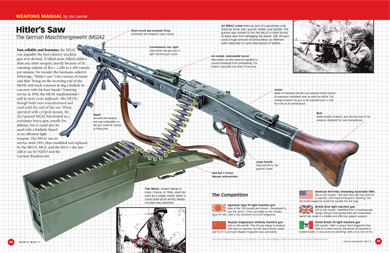WILEY T. MOORE’S BELT-FED BAR

In December 1933, Wiley T. Moore patented his design to convert the M1918 Browning Automatic Rifle into a belt-fed light machine gun. Moore designed the weapon while based at the United States Army Air Corps’ research and development center and armourer training facility at Wright Field, Ohio.
Moore’s design sought to improve on the BAR’s rate of fire which is inherently hampered by its 20-round box magazine feeding system. Moore hypothesises that:
“The gunner just about gets on this target when it is time to reload. These frequent interruptions have the effect of disarming the gunner for considerable periods of time during which he is exposed to the deliberate aimed fire of the enemy. Under these conditions the gunner naturally develops a tendency to reopen fire before the gun is properly aimed or directed and as a result his efficiency is impaired and a large amount of ammunition is wasted.“
Moore felt that with thousands of BARs already in the US Army’s inventory it was a logical step to attempt to convert them to feed from belts with “a minimum substitution of parts and without requiring extensive modification of the retained units or interfering with the standard characteristics of the gun.”

Carl Gustaf Prototype Belt-fed Light Machine Gun m/1937 (source)
The operation of the firearm is not altered by Moore’s conversion, however, a ‘feeding box’ is added to reliably feed the belt into the weapon’s action (see image #4). Moore’s patent explains that the weapon’s belt feed was linked to the piston with a slide which has a feed pawl mounted on a pivot pin. As the action cycles the piston acts on the feed slide which cams the pawl left to right to pull the belt into the action. A round was then stripped from the belt and fed into the action as the bolt returned home. Moore’s patent stipulates the use of disintegrating links, a system that he himself had patented in 1933.
Moore’s conversion also added a pistol grip, much as the Colt Monitor and FN’s Model D. FN also experimented with developing a belt-fed variation of Browning’s design with Rene Laloux filing two patents in 1935 and 1936. In 1937 the Swedish firearms manufacturer Carl Gustav developed a cumbersome looking prototype belt-fed version of the Swedish Army’s Kulsprutegevär m/37 light machine gun, it was not adopted. Moore’s BAR conversion was not adopted either, it is unclear if the design was formally tested. In 1934 the US Army Ordnance Corps had evaluated and apparently rejected Moore’s T12 Light Machine Gun. later during World War Two Colonel Wiley T. Moore became the chief of the engineering group of the Small Arms Division.
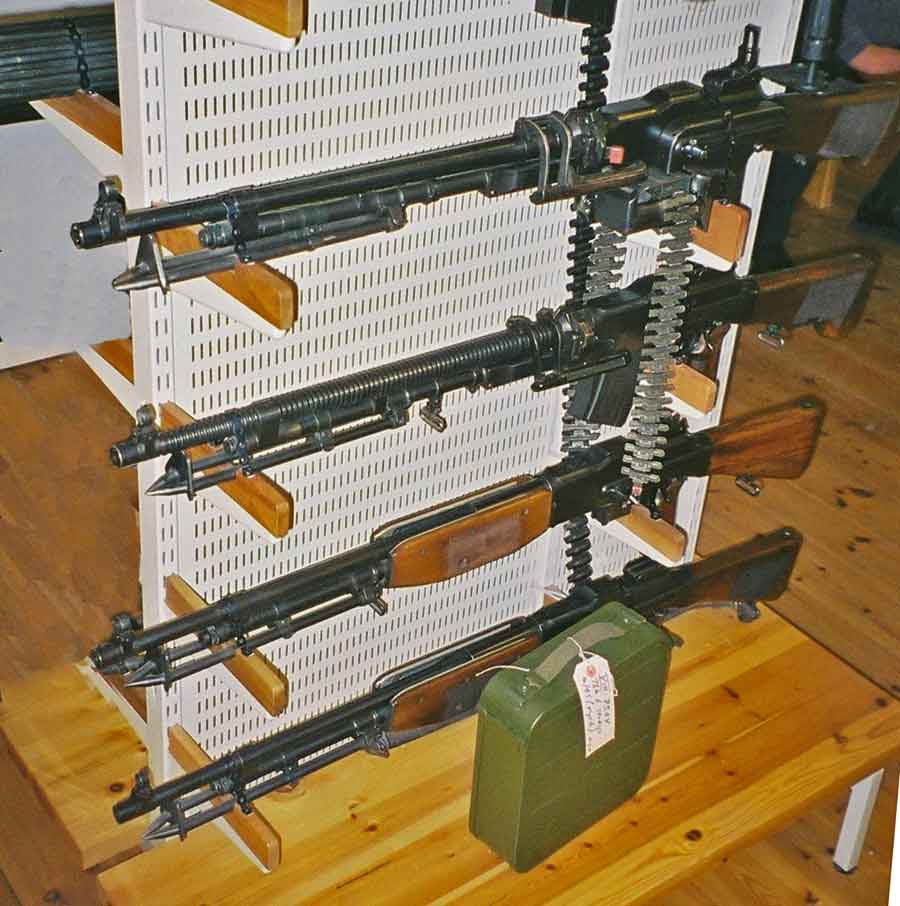
The light machine guns in the Swedish army based on the BAR 1918 family all in calibre 6,5x55 mm
Top to bottom:
Kg m/1937, belt fed
Kg fm/1935 (later without the flanges which became Kg m/1937)
Kg m/1921, produced by Carl Gustafs Stads Gun Factory
Kg m/1921 produced by Colt USA (with pistol grip).
Picture from Carl Gustafs Stads Gun Factory Weapon Museum.
The Browning Calibre .30 Automatic Rifle (BAR)
The Browning Calibre .30 Automatic Rifle (BAR) was developed by John Moses Browning in 1917 to meet the U.S. demands for an automatic rifle in the Great War.
 The U.S. BAR M1918
The U.S. BAR M1918
The Browning’s patent drawing can be seen below.
The BAR was made by Colt, Winchester and Marlin Rockwell during WW1. The original BAR has no bipod. The flash hider is simple tube and the sight is similar to the Enfield rifle M1917.
Some 82 000 BAR M1918 were made in USA before the end of WW1.
The Swedish BAR:s are quite similar to the U.S. BAR M1918 except that it has a separate pistol grip and are all made in the Swedish m/94 6.5 mm calibre. The Swedish modification was developed by the Swedish government arsenal, Carl Gustaf Stads Gun Factory in Eskilstuna, Sweden.
This is the drawing from August 1917 of
J.M. Browning for his patent concerning the Browning Automatic Rifle (BAR).
For a large size of this drawing
1248x1620 (165kb)
CLICK HERE>>> 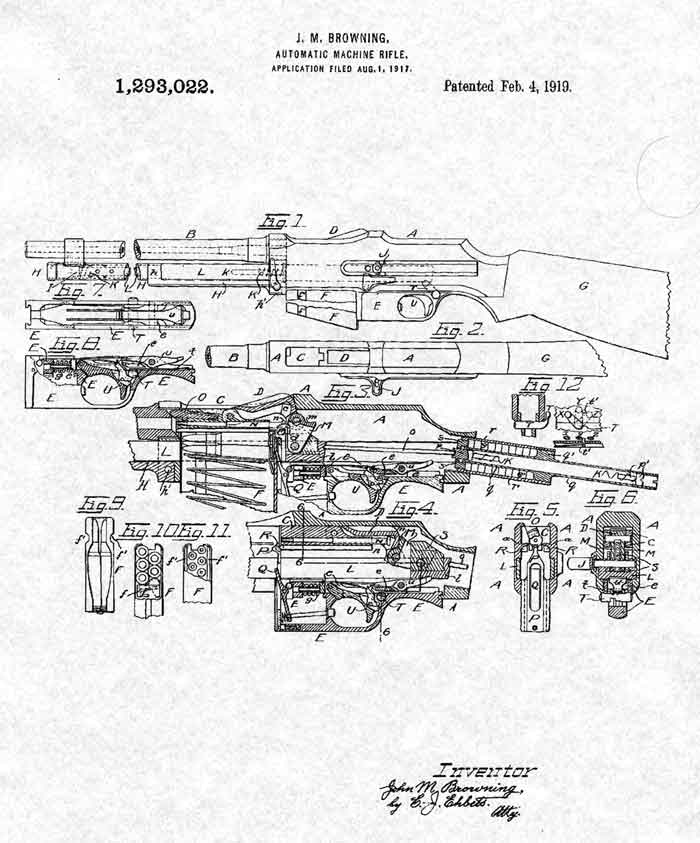
Light machine gun Kg m/1921 (BAR).

LMG - Kg m/1921
After the Great War Sweden bought some BAR m/1918 from Colt manufacturing Co. in USA made to Swedish specifications. The most obvious difference was a removable pistol grip on the Swedish gun.
Later the machinegun was produced under license in Sweden at Carl Gustafs Stads Gun Factory in Eskilstuna and it was called kg m/1921 (Kg = KulspruteGevar literally “Bullet Spraying Rifle”).
The Kg/21 produced by Carl Gustafs Stads Gevarsfactory in Eskilstuna.
Between the wars Kg m/21 was a main support weapon for the Swedish army together with the Swedish produced water cooled medium machinegun Ksp m/1914 (Austrian Schwarzlose M07/12, also made by Carl Gustaf Stads Gun factory in Sweden).
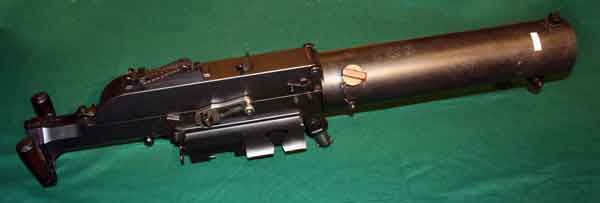 Medium water cooled
Medium water cooled
Machine Gun (MMG):
Ksp m/1914
(Austrian M07/12 Schwarzlose)
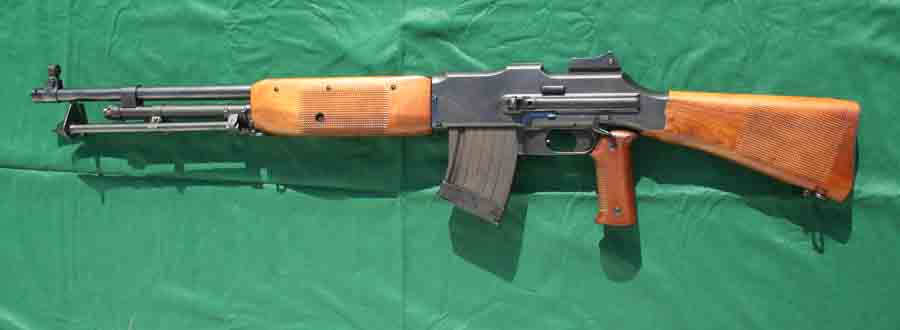
LMG - Kg m/1921
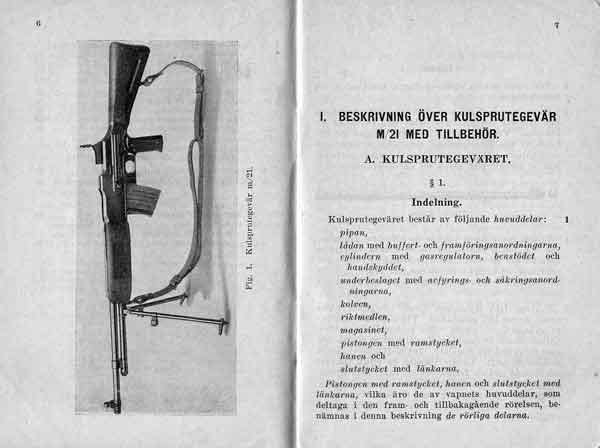 Swedish army instruction manual for
Swedish army instruction manual for
LMG m/1921
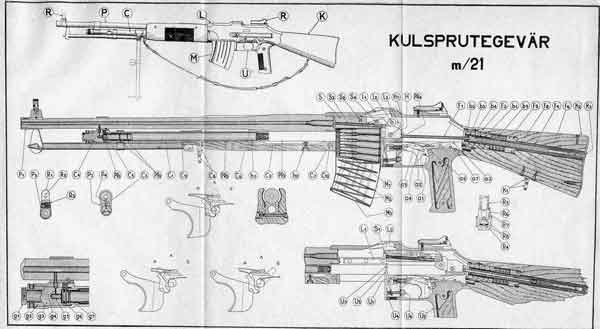 Here is a drawing of the Swedish kg m/1921 from Swedish army. Click on the picture to enlarge it.
Here is a drawing of the Swedish kg m/1921 from Swedish army. Click on the picture to enlarge it.
Click on the drawing to make it larger.

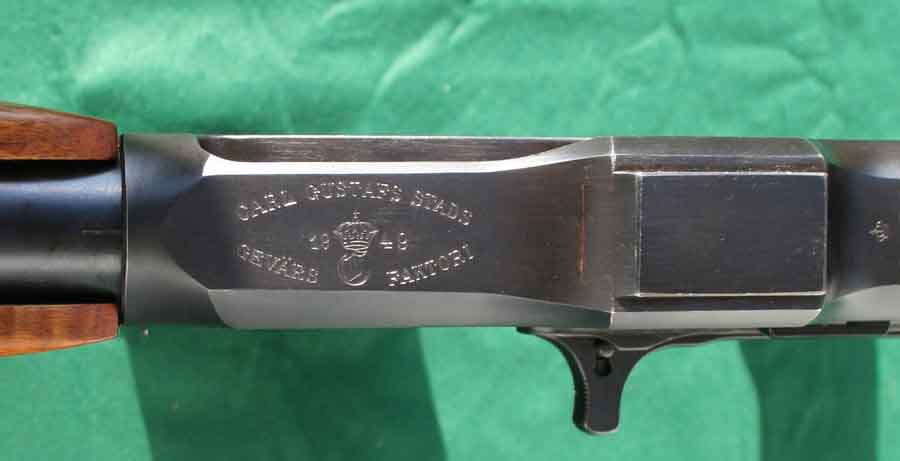
The receiver of LMG - Kg m/1921
One of the very last made Kg m/1921 made by Carl Gustafs Gun Factory 1949. Note the acceptance crown on top of the receiver.
The weapon was used by the author in the Swedish army artillery units 1971. It is easy to handle in full automatic due to its weight and slow cyclic rate. The Swedish army trained the soldiers to use it as an automatic rifle and shoot single shots like a rifleman and only to use full auto during attacks.
Light machinegun made by Fabrique Nationale used by the Swedish.
Light machine gun m/1930 made by Fabrique Nationale (FN BAR)

The top line of the plate in the upper right corner says (Picture from Carl Gustafs Stads Gun Factory Weapon Museum.):

Sweden had bought a small number of the FN BAR M1930 with fixed barrel 1930 from Fabrique Nationale and it was called Kg m/1930 in Sweden.
Light machine gun Kg m/1935 (FN BAR type D)

LMG Kg m/35
The top lines of the plate in the upper right corner says:
Picture from Carl Gustafs Stads Gun Factory Weapon Museum. 
The major drawback on kg m/21 (and m/30) was the fixed barrel which burned out fast during full automatic fire. To change the barrel of a kg m/21 needed the help of a skilled gunsmith.
Fabrique Nationale had solved the problem burned out barrels by making a gun with exchangeable barrels. These LMG are known as FN type D.
Sweden bought a small number of these FN BAR type D and they were named Kg m/1935.
Light machine gun Kg m/1937 (BAR)
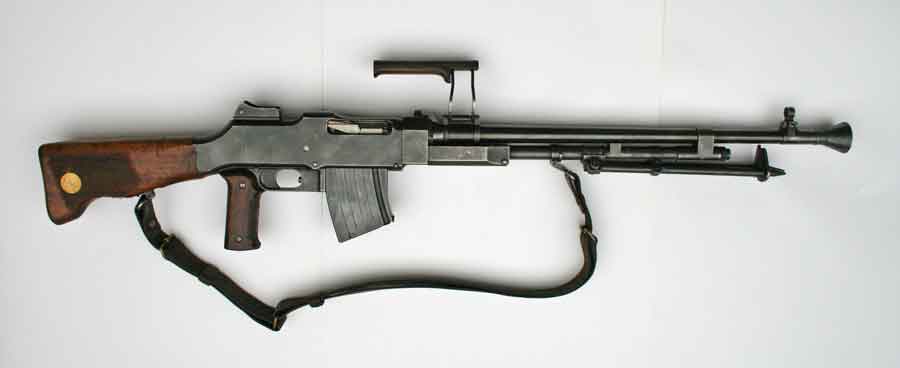
LMG - Kg m/19****37
1935 the Carl Gustaf Gun Factory came with a clever solution to the problem with replaceable barrels. Instead of twisting the barrel, a lock was added to the front part of the frame. The barrel is brought into position without twisting and parts of the lock on the frame twist into groves of the barrel instead. This modification was tried successfully as fm/1935 (Trial Model /1935).
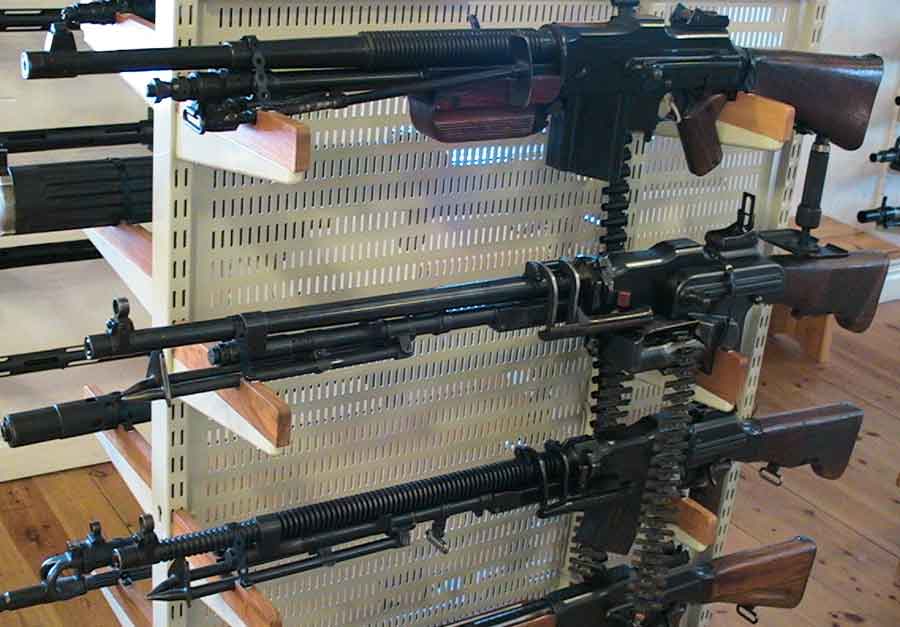
The LMG in the bottom of the rack (under the belt fed LMG) is Kg fm/35.
The barrel of Kg fm/35 had many many cooling flanges.
(Picture from top to bottom Kg m/30, beltfed Kg m/37 and Kg fm/35 and the rear part of Kg m/21.)
Picture from Carl Gustafs Stads Gun Factory Weapon Museum.
The flanges on the barrel of Kg fm/35 were removed on the accepted model Kg m/37.
With this modification the LMG was accepted 1937 as kg m/37.
Kg m/37 - The main support weapon of the Swedish army.
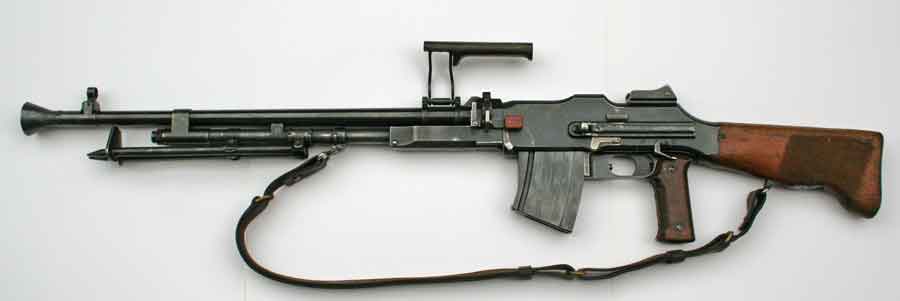
LMG - Kg m/1937

